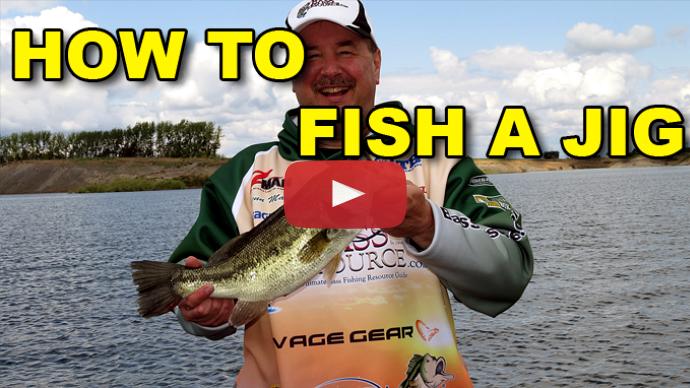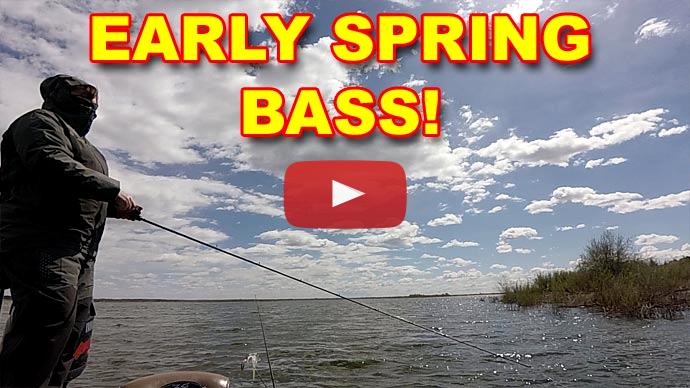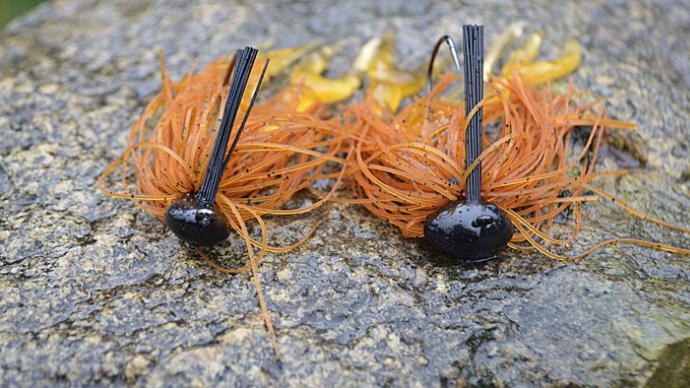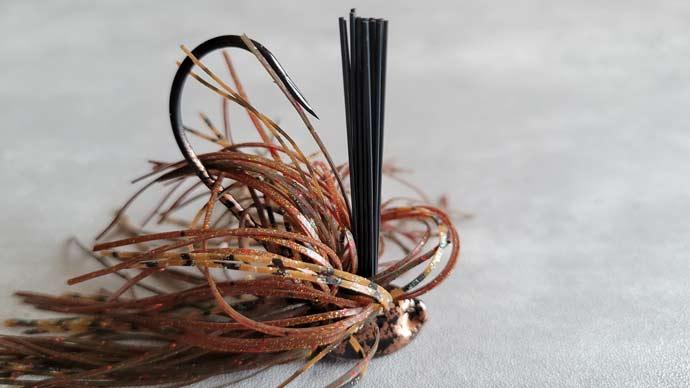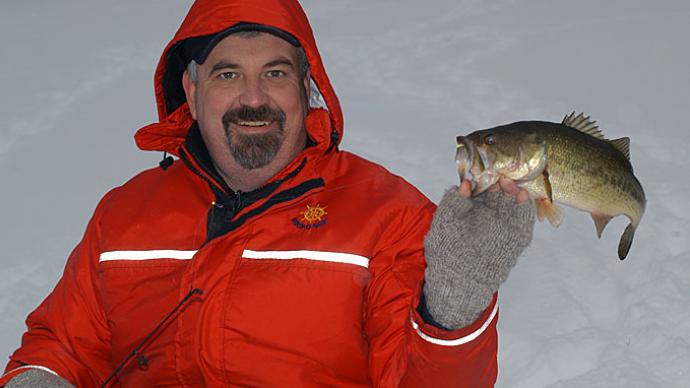Glenn: That was a pick-up. It just got light. I just lost the weight. There we go. Cold water jig fish. All right. Not a huge one, but I'll take it in the wintertime.
Hey folks, Glenn May with BassResource.com and today let's talk about fishing jigs in deep cold water. I know it can be a little bit of a daunting task for some folks, and it's a little bit of art and a lot of science, so let's get down to it. We're gonna go through the different pieces of gear to use. What rods, reels, line, etc., even the jigs, and then talk about really how to find the fish and finally how to catch them because there's some big lunkers out there. And hopefully, after you see this video, you'll be able to go and catch some of them.
So let's start off with the gear. Right here, got a baitcaster here that's a 7:3:1 gear ratio. I would recommend something between a 7:1 and a 7:5, or a 7:1 gear ratio. What seems to happen every time when you catch a fish deep, they go Polaris on you. They go straight up and they head for the surface, and sometimes they do it really fast, and you need a fast gear ratio to catch up to them and keep that line taut as it comes up. So that's why I use fast gear ratios.
The line I'm using, I use Seaguars usually InvizX but sometimes AbrazX line, 17 pound fluorocarbon. That I prefer when you're fishing deep because what you're doing most of the time is you're fishing rocky structure, or you may have rock cover both in the form of boulders or big chunk rock. Sometimes you'll have some wood down there so it's either a treeline or maybe you're fishing a stump row, something like that. But rarely are you gonna have vegetation. Braid doesn't do well on rocks. As a matter of fact, rocks is kinda like Braid's Kryptonite. It actually nicks up and frays the line faster and you actually cut it at times. So I don't use Braid in the situation. AbrazX works great. It's fluorocarbon so it has that sensitivity. You maintain a better connection to that jig. You've got that sensitive straight-line connection to it. And it's also really abrasion resistant against all that rocks and stuff that you're gonna be dragging it across. It holds up really well, so that's why I use AbrazX.
Now the jig, I wanna talk a little bit about the jig. These jigs come in all kinds of different sizes, different shapes, different types. But for fishing deep water what I really prefer is a football jig, specifically, well, for several reasons. Football jig, you notice the weight is in the front, so it's weight forward. You're gonna need that because it will fall straight down. It falls vertically. If you're using that jig that says "Designed for vegetation." It has that cone nose, that bullet head nose, it can swirl and spin and dive off to one side, and it won't get that straight drop that you need. Plus it's not all weight forward. The weight's distributed a little bit further back. So a football jig does the trick there. Plus, the action of this football jig when you pull it across the bottom, it has this kind of wobbly side to side action, which you’re trying to mimic a crawfish. So, it really looks like a crawdad, kind of crawling across the bottom meandering, making it's way across the bottom. So a football jig does a perfect job of that.
If you notice, this is a really big football head jig. Look at the size of that head, man. I use between a half ounce and one-ounce size jig. This is a three-quarter ounce. Several reasons for that. First of all, in this time of the year in fishing deep, the fish aren't suspended up. They typically aren't in the mood to chase. You're looking at colder water temps. I'm talking about temps that are under 50 degrees, sometimes getting into the low 40s and upper 30s. Bass aren't gonna race up and chase after a jig that's falling when under those conditions, so a slow fall is not a critical component. Keeping it on the bottom and maintaining contact with the bottom is. Especially a lot of times when you have this cold water conditions, you have adverse weather. And when you're out in these conditions, trying to maintain contact in the bottom with a jig is really difficult, especially when it's windy. So, a heavy jig is in tall order for that. You can keep it on the bottom, maintain contact and it helps you detect those subtle bites.
So, with the trailer here, if you notice, it's a different kind of trailer. Typically what I like to use is a Rage Craw trailer. It's got those flanges on the craws and it makes it flippity-flop as it falls and gives it action as you crawl it across the bottom. Cold water situation, crawdads aren't super active. They're moving really slow and lethargic. That's what the cold water does to them, so a bait that has a lot of movement and action to it looks out of place to the bass. It's just not natural. So, I'm not using Rage Craws. Instead, I'm using a trailer that has a lot less action. It's more just straight fall. This one happens to be a V&M Cherry Bug trailer, but you can also use a Zoom chunk trailer. That's a dynamite trailer to use, especially when you're fishing cold deep water jigs. There we go.
Keri: Yee-haw. We got a fish. We have a smalley or largey?
Glenn: We got a largemouth.
Keri: Got a largemouth. A nice largemouth too.
Glenn: There we go.
Keri: Nice fatty.
Glenn: Look at that.
Keri: Look at the light color.
Glenn: Boy, he is cold.
Keri: I bet he is cold.
Glenn: Cold water jig fishing. Come on, get the jig out. Look at that.
Keri: You could barely see his stripe.
Glenn: Yeah.
Keri: He's so light.
Glenn: He's deep.
Keri: Nice looking...
Glenn: So let's talk now about how do you find these fish? Because, boy, if you just talk deep water jigs, well yeah, you could start looking them on the map, find some deep water and just start fishing. Maybe you can some points and some humps and ridges and just start fishing those and maybe you'll catch some fish that way. But really, there's a methodology behind it and it begins with map study.
What you want to do is look at where are the spawning flats and the spawning areas on the lake. If you're familiar with the lake and you fished it for a while, you may even know where those right away. But if you don't, and even if you still do, get the map out. Find those spawning flats and those spawning bays, and now start to work your way out to deeper water. Look at those secondary points, those humps, those ridges, those ledges, all the way out to the main lake. And even in lakes that aren't a reservoir. You're still gonna have those shallow areas and deeper areas. Try to find those deeper areas that are nearby, relatively nearby to those flats and the spawning areas. That's what you wanna find. You can find deep spots and ridges all over the lake, but the ones that are relatively close to the spawning areas, that's the key.
Bass really have only two things they need to do in life, eat and spawn. So if they can find an area where the food is nearby where they can go spawn, they don't have to go very far to spawn and they can get the food in their immediate area around that, they're not gonna go far. That's an ideal place for them to set up house, so that's what you wanna look at. They're not gonna roam three or four miles unless they have to, so don't go too far away from those spawning areas.
Deep is relative. In my neck of the woods, when it gets to wintertime, fish are finding...they're 45 to 55 feet deep in some lakes. In some reservoirs out west in California, you could look in a triple digits. Whereas in Louisiana, 10 to 15 feet is really deep in some of those areas, so keep that in mind.
But what you're looking for on the map is two things. First of all, you wanna find points. Long tapering points would be great, even sharp points even better. You wanna find ridges, humps, sunken islands, ledges, channel swings that come up close to the shoreline. Specifically, when you're looking at the map, I want those contour lines to be nice and sharp close together. Almost a black solid line. Those kinda sharp drops, that's what's important for deep jig fishing, because the fish can move up and down the water calm real easy. And as long as there's some cover or some kinda structure nearby that they can be associated with, boom, you found yourself a hotspot. So I like to find those points. Hopefully, a channel swing that comes by a point. Now you've got one section that's really sharp drop, the rest of it's tapering where they can roam on when they need to, that's the kinda stuff I like to look for because it provides a variety of different topographical areas for the fish to set-up on. Look at that. Good fish. It's a good fish, honey.
Keri: Gotta watch up with him, he's heading out here.
Glenn: He's coming right out to deep sea. Nice.
Keri: He hit it right when it hit the water up there right at the edge.
Glenn: He was right there. Believe it or not, in this cold water. Do you want me to grab it for you?
Keri: Yeah. Can you get the net? Please?
Glenn: Net coming up.
Keri: Hurry, hurry, hurry. He is not happy.
Glenn: Well that works.
Keri: Well that does work. Look at that. Wow, he's a nice one.
Glenn: That's a good fish. Good fish.
Keri: Nice. Hit it right when it hit the water right at the end.
Glenn: Yeah, I saw where you cast.
Keri: Oh, he's heavy.
Glenn: Oh yeah. He's a good one.
Keri: He's got some weight to him too. Hi guy. Got you right in the nose. You are cold. Take a picture.
Glenn: Cold water fishing. So, find those areas and mark them. Put them on your GPS. Get out there. And what I like to do is I like to go over the top of them and scan them as long as they're deeper than 20 feet deep, because I don't want to spook them when bringing a boat over them. I'll scan over that and I'm looking for bait fish or any kind of bait fish activity anywhere in the lake, and I try to get an idea of where that bait fish is holding on. Say for example, they're positioned in 30 feet of water. Now, I look on that map and I look for all the different places I've marked that intersect with 30 feet, those are the spots I'm gonna check first, or say it's 40 feet, 50 feet, whatever it is.
See, there's an approach to this than just haphazardly fishing in areas that look good. Okay, so a little bit of homework ahead of time will help you be more productive on the water. So, once you find those areas and you've scanned over them and you've taken a look, maybe you can find some additional cover on those areas. Say, for example, some stumps or some boulders, make sure you mark those because those are spots within a spot that fish could be holed up on.
Now, let's get into how to fish it, and this is, like, really important because it's all about catching the fish. So, go up on your piece of structure, you've got your big jig here. First thing I'd like to do is I position the boat out deep and I cast up into shallower water, and what I wanna do is I wanna drag the jig over that piece of structure. Drag it. Not hop, skip, jump, make all this movement like you normally would when the water temperature is warmer. That's when the crawdads are more lively. Of course you're gonna have that kind of action. It's cold. The water temperatures is really cold like I mentioned. The crawdads move really lethargic, so the only thing you got to do here is keep it on the bottom. Crawl it. Crawl it slowly. I'll either do that with my reel handle or what I really like to do is take my rod and move it with my rod because I can watch the rod tip. It gives me an idea of how fast I'm really going. If I'm moving it with the reel, you kinda have to think in your head how fast it's moving because you're just moving line. So I move the rod tip.
Plus, as I get the rod tip further out away from me to the side, you get more sensitivity. You can feel those real subtle pickups, and this is where you really have to focus. Those pickups, what you're doing is you're presenting a bait that looks vulnerable and that's not gonna move fast. And it's also big, so it's lot of protein. Lots of calories. That is candy for bass. Very opportunistic. They don't have to rush down, chase it down, and hammer it. So, your strikes aren't gonna be really strong because they're not going after it. They're just gonna swim up to it and go, and they may even stay in place. So your bites are gonna be really soft. Moving the rod to the side, moving with the rod, you'll feel you're bumping along the rocks. They're vibrating. You can feel all coming up through the AbrazX. Bump, bump, bump, bump, bump, and then it might go to a thud, thud, thud, thud, or it just might get lighter. You'll just kinda like stop bumping and it's lighter as you're pulling along, you're like, "What happened?" Probably a fish picked it up. It's that subtle. So, pay real close attention to the feel, and also what where the line is entering the water. Sometimes all you'll see is just the line doing a little pop or might just start to move off to one side. And if you didn't do that, something on the other end is, so set the hook.
So you have to maintain focus, and it's hard to do when it's cold out. So, you got to really stay in tuned to what you're doing. But drag it over the piece of structure, once you do that, multiple casts are key to this technique because a lot of time it's the angle that's important when you're deep jig fishing. The piece of structure, you pull it and make sure you're going to some sorta pattern, so you crisscross as you go around it. So, you make a very methodical approach and cover it at different angles because sometimes all it takes is getting across that sweet spot in the structure and at the correct angle and boom, you'll pick up a fish. Really? Nice.
Keri: Another nice large one.
Glenn: Wow, you got the magic touch today. You need the net on that one too?
Keri: Yeah, please.
Glenn: Come here net. There you are.
Keri: Look at me. Look at me. Look at me. I got the magic touch today. All right.
Glenn: Cold water fishing.
Keri: And this fish is cold.
Glenn: Cold water jigs.
Keri: Not as big as the last one, but I'll take it.
Glenn: Now, once you catch a fish, bring some buoys along. Marker buoys, because what I do is I'll kick a marker buoy over the side of the boat. That's not the position where the fish are. I mark it right next to the boat because now I've got the angle relative to that structure figured out that's where I picked up a fish, so I wanna replicate that. So mark it. Put the buoy down. Now, you can keep that boat next to that marker buoy and keep making casts with that angle with this jig. And a lot of times you won't be fast and heavy action, it's not like you can catch a fish every single cast. But, you will increase your likelihood of catching more fish off that piece of structure now that you figured out what cast you need to make.
Once you clear out that area and catch a few more fish and the bite dies off, then move down and go to the next piece of structure, be it a point or a hump or ridge, and just rinse, lather, repeat.
With that kinda methodical approach, that is going to help you catch a lot more fish.
But one of the thing that I want to talk about here, besides dragging it, and this is what I talked about before, they want this vertical drop because the structure has that real sharp drop. A lot of times what you're doing is you're pulling it right along, along, along, and then you hit to that drop and it boom. It falls 5, 10, 15 feet, whatever it is. The fish are sometimes gonna be positioned right along that edge or right on what I call the knee, right in the bottom where it connects to the bottom of the lake. If you're using a different kinda jig like I said that kinda swirls and goes down, what happens is that it'll swim out and land away from that knee, or it'll pull away from that ledge. Make that cast. Pull up to the edge of that drop, and when it starts to drop hit the button and let her freefall. Just peel out some line if you need to. Peel it out. Peel that line, because you want it to fall straight down, a vertical drop right along that edge. That's why that football jig works so well because it does fall straight down, but you have to work it too. That vertical drop is critical to keeping it in the strike zone.
So, that's how I fish at deep water, in cold water. Maintain confidence, keep your focus, and by all means, stay warm and have a lot of fun catching a lot of big bass. Hope that helps. For more tips and tricks like that visit BassResource.com.

